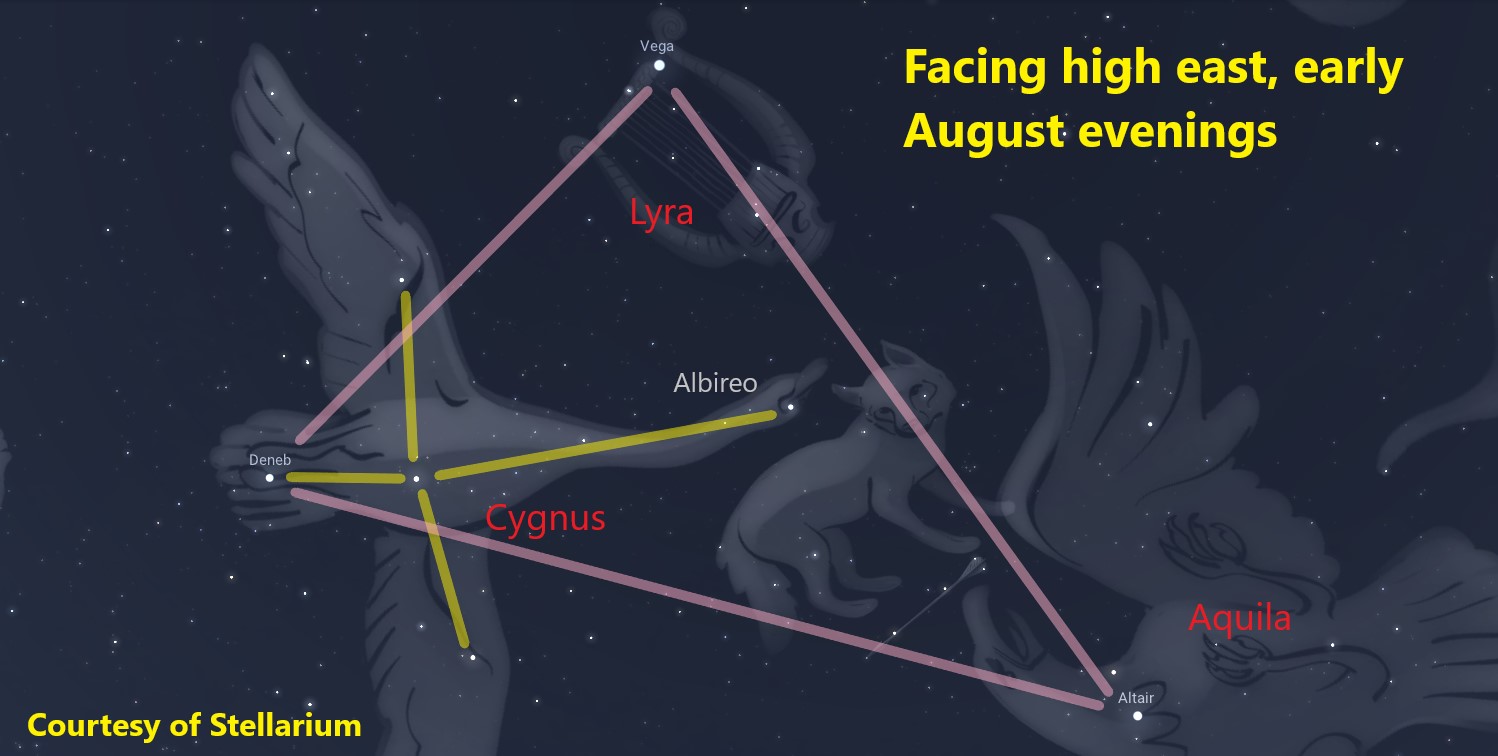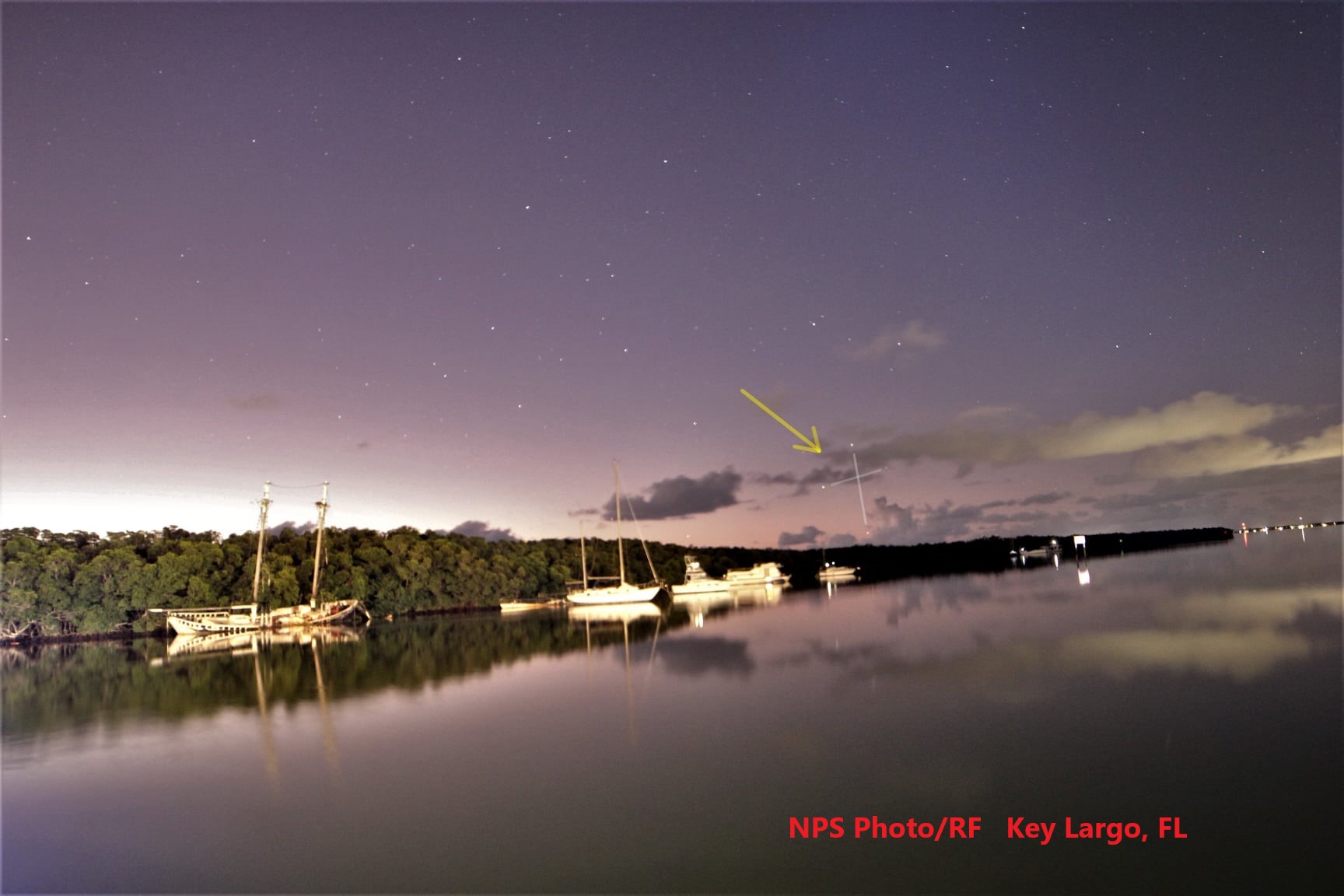DOUBLE CROSSES IN THE SKY
During the early part of August, the heat of summer is still at or near its peak. Although each year is different, some moderating of the temperatures is usually noticeable by the end of the month- but August is still a good month to cool off in a swimming pool. The skies of August feature a “swimming constellation”- Cygnus, the Swan. One of the easiest constellations to spot in the night sky, Cygnus is also one of the few that looks something like its namesake.

The best way to locate Cygnus is identify the three bright stars that form the Summer Triangle. Just about straight up during early August evenings is Vega, which has a noticeably bluish-white tint to it if you look closely. High in the eastern to southeastern sky is Altair, the next bright star to Vega’s lower right at this time of evening. Completing the triangle, to the lower left of Vega, is Deneb. Deneb is the dimmest of the three, but still ranking as first magnitude in brightness. However, this apparent brightness is completely misleading, as this star is more than 100 times farther away than Vega. With one light year spanning nearly 6 trillion miles, Deneb is an astounding 2,600 light years away, one of the most distant stars visible to the naked eye. You can learn more about these stars of the Summer Triangle by visiting the September 2021 and July 2022 editions of this blog.
Deneb is the brightest star in the constellation of Cygnus, the Swan. In mythology, Cygnus represents the beautiful swan that Zeus changed himself into in order to pursue Leda, a princess. According to the story, the swan jumped into Leda’s arms, supposedly in fear of a passing eagle. This was not the only time the King of the Greek gods resorted to devious means to get what he wanted. In this same mythology, Phaethon, the son of Helios, the sun god, begged his father for permission to drive the Sun Chariot across the sky, creating day and night. Typical teenager! Eventually, no doubt against his better judgment, Helios reluctantly agreed. He quickly came to regret this decision as the chariot went out of control, alternately approaching too close to or drifting far from the Earth, creating burning deserts and frozen wastelands, which of course are still there to this very day. Zeus finally had to put an end to the catastrophe by unleashing one of his thunderbolts, killing Phaethon, whose body fell into the river Eridanus (also a constellation of the fall and winter skies). His faithful friend Cycnus jumped into the river and continually ducked his head into the water in search of Phaethon’s body, and Zeus, watching closely, immortalized the scene by placing Cycnus into the sky in the form of a swan.
To most people, the stars of Cygnus look far more like a cross than a swan. To trace the Northern Cross, start with Deneb, and then notice three stars in a row in a more or less vertical line. Draw a line from Deneb through the middle star of these three, and the next fairly bright star you see is Albireo, which would mark the swan’s head or beak. If you happen to own a decent telescope, aim it at Albireo, and you will see that it is one of the most striking binary stars in the sky- revealing itself to be a pair with one star golden yellow and the other a vivid blue. Those of you who have access to darker sky locations or who use binoculars can better spot the dimmer stars that fill out the wings of the celestial swan.
In ancient times, the famous Southern Cross was visible from mid northern latitudes. It will be once again in several thousand years more, but the wobble (nutation) of Earth’s axis currently points most of the Northern Hemisphere away from this star group, whose official name is the constellation Crux. Although best seen from south of the equator, Crux just peeks above the southern horizon during spring evenings as seen from southern Florida or Hawaii. This past winter, during a family trip to the Florida Keys, I could just see the Southern Cross, above the water as dawn started to brighten the sky.


Don’t miss our next Gateway to the Stars program, held Sunday evening August 14. Astronomer Richard Heuermann will discuss the development and discoveries of the new James Webb Space Telescope. This free program will take place in the Park’s Education Classroom at 6:45 pm. Weather permitting, it will be followed by free telescope viewing, led by our Sky Ranger and volunteers from the St. Louis Astronomical Society. The series will continue on September 3 with “Lights Out Heartland,” featuring Dark Sky Missouri and the St. Louis Audubon Society. The impact of light pollution upon wildlife will be discussed
